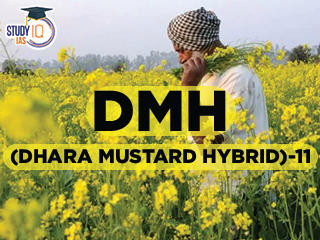Table of Contents
Dhara Mustard Hybrid Crops
- Hybridisation involves crossing two genetically dissimilar plant varieties that can even be from the same species.
- The first-generation (F1) offspring from such crosses tend to have higher yields than what either parent can individually give.
- Such hybridisation isn’t easy in mustard, as its flowers have both female (pistil) and male (stamen) reproductive organs, making the plants largely self-pollinating.

- Genetically modified organism (GMO) is any living organism whose genetic material has been modified to include certain desirable techniques.
- Genetic modification has previously been used for the large-scale production of insulin, vaccines, and more.
- In crops, genetic modification involves the manipulation of DNA to alter certain characteristics of the crop.
- Soyabean, maize, cotton, and canola with herbicide tolerance and insect resistance are the most widely grown GM crops around the world.
- Other common genetically modified characteristics include virus resistance, drought resistance, and fruit and tuber quality.
- Science of GM crop: To genetically modify a crop, the gene of interest is identified and isolated from the host organism.
- It is then incorporated into the DNA of the crop to be grown.

Dhara Mustard Hybrid GM Crops in India
- Indian farmers are cultivating Bt cotton since in 2002-03.
- Bt modification is a type of genetic modification where the Bt gene obtained from the soil bacterium Bacillus thuringiensis is introduced into the target crop.
- Bt cotton is resistant to bollworm, a pest that destroys cotton plants.
- By 2014, around 96% of the area under cotton cultivation in India was Bt cotton, making India the fourth-largest cultivator of GM crops by acreage and the second largest producer of cotton.
Concern with Dhara Mustard Hybrid GM Crops
- GM technologies could compromise food security, lead to seed monopolies and become biosafety hazards.
- Coalition for a GM-Free India, an umbrella organization that opposed Bt brinjal too, said the approval for the GM mustard process lacked “scientificity or responsible regulation”.
- It will cause displacement of manual labour engaged in weeding by promoting use of chemical herbicides.
- Honeybee Population: GM mustard threaten or undermine the population of honey bees.
- However, an expert committee under Department of Biotechnology, found out that the bar, barnase and barstar system will not pose an adverse impact on honey bees and other pollinators.
Dhara Mustard Hybrid GM Regulatory framework in India
- Strict regulations are in place to control threats to animal health, human safety, and biodiversity at large during the processes of development, cultivation and transboundary movement of GM crops.
- Acts and rules that regulate GM crops in India include:
- Environment Protection Act, 1986 (EPA)
- Biological Diversity Act, 2002
- Plant Quarantine Order, 2003
- GM policy under Foreign Trade Policy
- Food Safety and Standards Act, 2006
- Drugs and Cosmetics Rule (8th Amendment), 1988.

About Genetic Engineering Appraisal Committee (GEAC)
- GEAC under the Ministry of Environment, Forest and Climate Change (MoEF&CC), is responsible for the assessment of proposals related to the release of genetically engineered organisms and products into the environment, including experimental field trials.
- GEAC or people authorised by it have the power to take punitive actions under the Environment Protection Act.





















 WhatsApp
WhatsApp